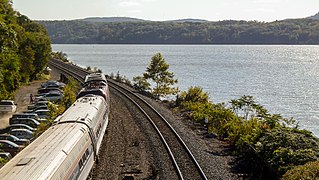Related Research Articles

The National Railroad Passenger Corporation, doing business as Amtrak, is the national passenger railroad company of the United States. It operates inter-city rail service in 46 of the 48 contiguous U.S. states and three Canadian provinces. Amtrak is a portmanteau of the words America and trak, the latter itself a sensational spelling of track.
The Railway Labor Act is a United States federal law that governs labor relations in the railroad and airline industries. The Act, enacted in 1926 and amended in 1934 and 1936, seeks to substitute bargaining, arbitration, and mediation for strikes to resolve labor disputes. Its provisions were originally enforced under the Board of Mediation, but they were later enforced under a National Mediation Board.

The Pullman Strike was two interrelated strikes in 1894 that shaped national labor policy in the United States during a period of deep economic depression. First came a strike by the American Railway Union (ARU) against the Pullman factory in Chicago in spring 1894. When it failed, the ARU launched a national boycott against all trains that carried Pullman passenger cars. The nationwide railroad boycott that lasted from May 11 to July 20, 1894, was a turning point for US labor law. It pitted the American Railway Union (ARU) against the Pullman Company, the main railroads, the main labor unions, and the federal government of the United States under President Grover Cleveland. The strike and boycott shut down much of the nation's freight and passenger traffic west of Detroit, Michigan. The conflict began in Chicago, on May 11 when nearly 4,000 factory employees of the Pullman Company began a wildcat strike in response to recent reductions in wages. Most of the factory workers who built Pullman cars lived in the "company town" of Pullman just outside of Chicago. Jennie Curtis who lived in Pullman was president of seamstress union ARU LOCAL 269 gave a speech at the ARU convention urging people to strike. It was designed as a model community by its namesake founder and owner George Pullman.

The Norfolk Southern Railway is a Class I freight railroad operating in the Eastern United States. Headquartered in Atlanta, the company was formed in 1982 with the merger of the Norfolk and Western Railway and Southern Railway. The company operates 19,420 route miles (31,250 km) in 22 eastern states, the District of Columbia, and has rights in Canada over the Albany to Montreal route of the Canadian Pacific Kansas City. Norfolk Southern Railway is the leading subsidiary of the Norfolk Southern Corporation.
A lockout is a work stoppage or denial of employment initiated by the management of a company during a labor dispute. In contrast to a strike, in which employees refuse to work, a lockout is initiated by employers or industry owners.

Railroads played a large role in the development of the United States from the industrial revolution in the Northeast (1820s–1850s) to the settlement of the West (1850s–1890s). The American railroad mania began with the founding of the first passenger and freight line in the country, the Baltimore and Ohio Railroad, in 1827, and the "Laying of the First Stone" ceremonies and the beginning of its long construction heading westward over the obstacles of the Appalachian Mountains eastern chain in the next year. It flourished with continuous railway building projects for the next 45 years until the financial Panic of 1873, followed by a major economic depression, that bankrupted many companies and temporarily stymied and ended growth.

The International Association of Machinists and Aerospace Workers (IAM) is an AFL–CIO/CLC trade union representing approx. 646,933 workers as of 2006 in more than 200 industries with most of its membership in the United States and Canada.

The Sunset Limited is a long-distance passenger train operated by Amtrak on a 1,995-mile (3,211 km) route between New Orleans, Louisiana, and Los Angeles, California, with major stops in Houston, San Antonio, El Paso, and Tucson. Introduced in 1894 by the Southern Pacific Railroad, it is the oldest continuously operating named train in the United States.

Conrail, formally the Consolidated Rail Corporation, was the primary Class I railroad in the Northeastern United States between 1976 and 1999. The trade name Conrail is a portmanteau based on the company's legal name. It continues to do business as an asset management and network services provider in three Shared Assets Areas that were excluded from the division of its operations during its acquisition by CSX Corporation and the Norfolk Southern Railway.

The Transportation Communications Union (TCU) is the successor to the union formerly known as the Brotherhood of Railway Clerks and includes within it many other organizations, including the Brotherhood of Railway Carmen of America and the Brotherhood of Sleeping Car Porters, that have merged with it since 1969.
The following is a timeline of labor history, organizing & conflicts, from the early 1600s to present.

The Great Railroad Strike of 1877, sometimes referred to as the Great Upheaval, began on July 14 in Martinsburg, West Virginia, after the Baltimore and Ohio Railroad (B&O) cut wages for the third time in a year. The Great Railroad Strike of 1877 was the first strike that spread across multiple states in the U.S. The strike finally ended 52 days later, after it was put down by unofficial militias, the National Guard, and federal troops. Because of economic problems and pressure on wages by the railroads, workers in numerous other states, from New York, Pennsylvania and Maryland, into Illinois and Missouri, also went out on strike. An estimated 100 people were killed in the unrest across the country. In Martinsburg, Pittsburgh, Philadelphia and other cities, workers burned down and destroyed both physical facilities and the rolling stock of the railroads—engines and railroad cars. Some locals feared that workers were rising in revolution, similar to the Paris Commune of 1871, while others joined their efforts against the railroads.

The Amtrak Hudson Line, also known as the CSX Hudson Subdivision, is a railroad line owned by CSX Transportation and leased by Amtrak in the U.S. state of New York. The line runs from Poughkeepsie north along the east shore of the Hudson River to Rensselaer and northwest to Hoffmans via Albany and Schenectady along a former New York Central Railroad line. From its south end, CSX has trackage rights south to New York City along the Metro-North Railroad's Hudson Line. The Hudson Line junctions the Castleton Subdivision in Stuyvesant, Amtrak's Post Road Branch in Rensselaer and the Carman Subdivision in Schenectady. Its northwest end is at a merge with the Mohawk Subdivision. The entirety of the line overlaps with the Empire Corridor, one of Amtrak and the Federal Railroad Administration's candidate lines for future high-speed rail.

Martinsburg station is a railway station in Martinsburg, West Virginia, United States, served by MARC Brunswick Line commuter rail service and Amtrak Capitol Limited intercity rail service. The station has one side platform serving a siding track of the CSX Cumberland Subdivision, with a footbridge crossing the siding and the two main tracks to provide access to the preserved Baltimore and Ohio Railroad Martinsburg Shops complex.

Positive train control (PTC) is a family of automatic train protection systems deployed in the United States. Most of the United States' national rail network mileage has a form of PTC. These systems are generally designed to check that trains are moving safely and to stop them when they are not.

The Transportation Trades Department, AFL–CIO (TTD) is a constitutionally mandated department of the AFL–CIO. It was founded in February 1990 to provide AFL–CIO-affiliated unions whose members work in the transportation industry or who build transportation infrastructure a unified policy-making voice on transportation issues. TTD has 37 member unions as of October 2022.

The Rail Safety Improvement Act of 2008 is a United States federal law, enacted by Congress to improve railroad safety. Among its provisions, the most notable was the mandate requiring positive train control (PTC) technology to be installed on most of the US railroad network by 2015. This was spurred by the 2008 Chatsworth train collision the month prior to passage of the act. After two delays, the technology was operational on all required railroads by the end of 2020.
Railway Labor Executives' Association (RLEA) was a federation of rail transport labor unions in the United States and Canada. It was founded in 1926 with the purpose of acting as a legislative lobbying and policy advisory body. At times, it played a prominent role in setting rail transport policy in the U.S., and was party to six U.S. Supreme Court cases. It disbanded in January 1997, with representation, collective bargaining, and legislative lobbying assumed by the newly formed Rail Division of the AFL–CIO Transportation Trades Department.

Cedar Hill Yard is a classification yard located in New Haven, North Haven and Hamden, Connecticut, United States. It was built by the New York, New Haven and Hartford Railroad in the early 1890s in and around New Haven's Cedar Hill neighborhood, which gave the yard its name. Electrical catenary for electric locomotives was added to the yard in 1915. To handle increasing traffic as a result of World War I, the yard was greatly expanded between 1917 and 1920 with additional construction along both sides of the Quinnipiac River. The construction project added two humps where railroad cars were sorted into trains by gravity. The yard was further modernized in the 1920s, becoming one of the busiest railroad yards in the United States, and the most important yard in the entire New Haven Railroad system.
The 2022 United States railroad labor dispute was a labor dispute between freight railroads and workers in the United States. Rail companies and unions had tentatively agreed to a deal in September 2022, but it was rejected by a majority of the unions' rank-and-file members. Congress and President Joe Biden intervened to pass the tentative agreement into law on December 2, averting a strike.
References
- 1 2 3 4 5 6 7 8 9 Eaton, William J.; Woutat, Donald (June 26, 1992). "President Signs Bill to End U.S. Rail Shutdown". Los Angeles Times. Archived from the original on October 2, 2021. Retrieved October 2, 2021.
- 1 2 3 "Freight railroads, Amtrak stop dead in their tracks". Portsmouth Daily Times . June 24, 1992. Retrieved October 2, 2021.
- 1 2 Associated Press (June 24, 1992). "Nationwide rail strike averted". The Times-News . Retrieved October 2, 2021.
- ↑ Associated Press (June 24, 1992). "Northeast apparently escapes rail shutdown". The Telegraph . Retrieved October 2, 2021.
- ↑ United States Congress (June 26, 1992). "Actions - H.J.Res.517 - 102nd Congress (1991-1992): To provide for a settlement of the railroad labor-management disputes between certain railroads and certain of their employees". www.congress.gov. Archived from the original on October 2, 2021. Retrieved October 2, 2021.
- ↑ Cockburn, Alexander (July 17, 1992). "Congress shafted rail workers by intervening to end 'strike'". Moscow-Pullman Daily News . Retrieved October 2, 2021.